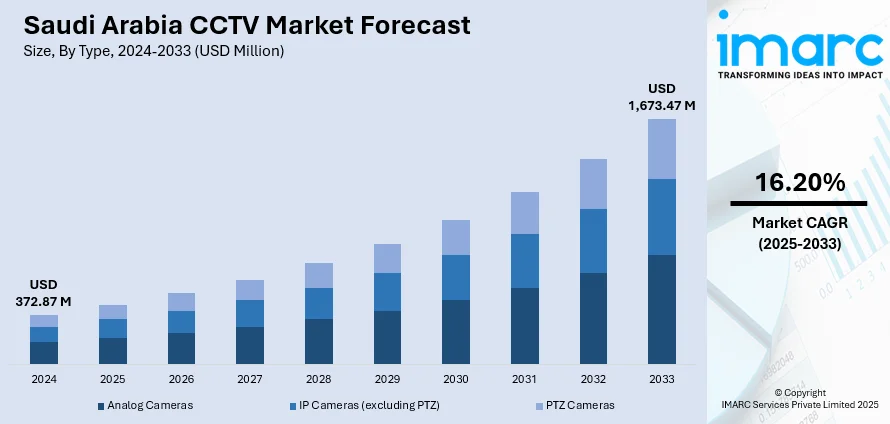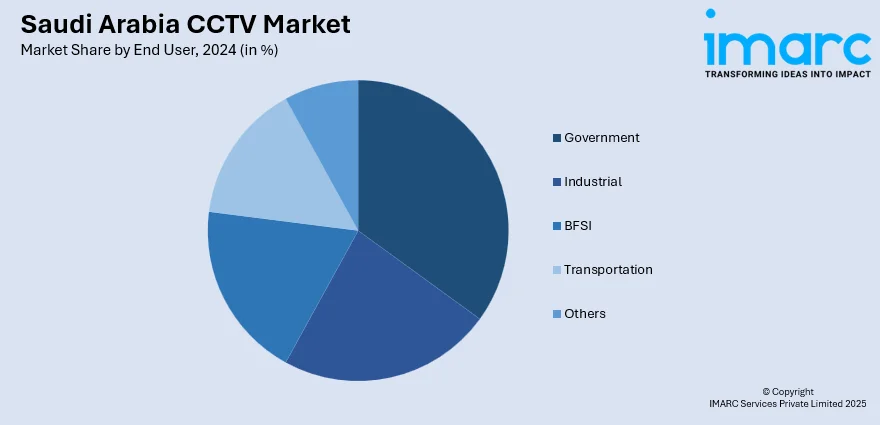
Saudi Arabia CCTV Market Size, Share, Trends and Forecast by Type, End User, and Region, 2025-2033
Saudi Arabia CCTV Market Overview:
The Saudi Arabia CCTV market size reached USD 372.87 Million in 2024. Looking forward, IMARC Group expects the market to reach USD 1,673.47 Million by 2033, exhibiting a growth rate (CAGR) of 16.20% during 2025-2033. The market is growing strongly led by The Vision 2030 plan which has resulted in greater investments being made in developing infrastructure, including transportation systems and smart cities. Increased security threats, including terrorism and crime, have also increased the demand for efficient monitoring solutions in public as well as private sectors. Advances in technology, such as the use of IP-based cameras and video analytics and regulatory requirements for the use of surveillance systems in different institutions have further accelerated the Saudi Arabia CCTV market share.
|
Report Attribute
|
Key Statistics
|
|---|---|
|
Base Year
|
2024 |
|
Forecast Years
|
2025-2033
|
|
Historical Years
|
2019-2024
|
| Market Size in 2024 | USD 372.87 Million |
| Market Forecast in 2033 | USD 1,673.47 Million |
| Market Growth Rate 2025-2033 | 16.20% |
Saudi Arabia CCTV Market Trends:
Transformation toward IP-Based Video Surveillance Systems
The Saudi Arabian market is undergoing a fundamental transformation where traditional analog solutions are being replaced by IP video surveillance solutions. The key market drivers are the growing need for video at higher resolutions for remote viewing and integration with smart devices. Moreover, IP cameras bring scaling options, flexibility, and enhanced functionalities such as motion detection and facial recognition, amongst other advanced capabilities. Cities like Riyadh, Jeddah, and Mecca are the frontrunners in this change, with urban and infrastructure development schemes adopting IP-based CCTV. The increase in government expenditure on IT and security infrastructure is also driving the transformation, pushing Saudi Arabia among the top countries in the region in advanced surveillance technologies in the Middle East.

Integration of AI and Cloud-Based Solutions
The convergence of Artificial Intelligence (AI) and cloud computing is revolutionizing the CCTV landscape in Saudi Arabia. Video analytics based on AI enable instant processing of CCTV feed, making advanced features like object detection, behavior analysis, and predictive maintenance possible. Cloud-based solutions enable centralized storage, remote monitoring, and scalability, allowing organizations to manage large volumes of video data with ease. These technological advancements are particularly beneficial for sectors like retail, transportation, and public safety, where timely and accurate information is critical. With the continuous developments in AI and cloud technologies, their implementation in CCTV systems will continue to enhance security operations and drive the Saudi Arabia CCTV market growth.
Government Initiatives and Regulatory Mandates
Government initiatives and mandates are instrumental in defining the CCTV market in Saudi Arabia. Moreover, the National Transformation Program and Vision 2030, promote the development of smart infrastructure using surveillance systems for public venues. In the year 2022, the Council of Ministers issued a decree demanding the installation of surveillance systems in all hotels, residential apartment complexes, sporting clubs, stadiums, and mosques under public facilities. Such legislative measures are driving the increase in the demand for CCTV systems across industries of hospitality, residential, and public services. Additionally, the government's interest in improving public safety and security via technological innovation has helped create a fertile environment for furthering CCTV market in the country. Recently in January 2025, the Ministry of Interior of Saudi Arabia announced stiff penalties for security provisions violators stemming from the Security Surveillance Cameras Law. The ministry stated any act of tampering, damaging, or sabotaging to CCTVs or their footage shall attract a fine of up to SR10,000. A fine of SR20,000 will be imposed on persons who share or release CCTV footage in an endeavor to regulate the use of surveillance systems and ensure that they respect individual privacy.
Saudi Arabia CCTV Market Segmentation:
IMARC Group provides an analysis of the key trends in each segment of the market, along with forecasts at the country and regional levels for 2025-2033. Our report has categorized the market based on type, and end user.
Type Insights:
- Analog Cameras
- IP Cameras (excluding PTZ)
- PTZ Cameras
The report has provided a detailed breakup and analysis of the market based on the type. This includes analog cameras, IP cameras (excluding PTZ), and PTZ cameras.
End User Insights:

- Government
- Industrial
- BFSI
- Transportation
- Others
The report has provided a detailed breakup and analysis of the market based on the end user. This includes government, industrial, BFSI, transportation, and others.
Regional Insights:
- Northern and Central Region
- Western Region
- Eastern Region
- Southern Region
The report has also provided a comprehensive analysis of all the major regional markets, which include Northern and Central Region, Western Region, Eastern Region, and Southern Region.
Competitive Landscape:
The market research report has also provided a comprehensive analysis of the competitive landscape. Competitive analysis such as market structure, key player positioning, top winning strategies, competitive dashboard, and company evaluation quadrant has been covered in the report. Also, detailed profiles of all major companies have been provided.
Saudi Arabia CCTV Market News:
- In January 2024, Hikvision signed a Memorandum of Understanding (MOU) with a company called Tahakom, which is a leading firm in Saudi Arabia focused on information technology, traffic control, and industrial safety. The accord was solidified during Tahakom’s trip to Hikvision’s main office in Hangzhou.
- In June 2024, Hikvision, a worldwide leader in cutting-edge security solutions, collaborated with alfanar, a significant industrial group in Saudi Arabia, to create a modern local manufacturing plant in Riyadh. This partnership seeks to enhance local manufacturing abilities by creating top-notch security products on-site. This collaborative alliance is entirely focused on realizing the aims of the Made in Saudi initiative — a national program created to support the Kingdom’s effort to reach its economic capabilities and meet the targets of Saudi Vision 2030.
- In February 2024, in partnership with Alat, a fully-owned subsidiary of the Public Investment Fund (PIF) in Saudi Arabia, Dahua Technology, a leader in video-centric AIoT solutions and services worldwide, announced plans to open its first overseas production facility. With a $200 million investment, this joint venture, Alat AIVisio Technology Co. Ltd. (AIVisio), plans to build a highly automated production facility for premium AIoT products and intelligent solutions in the commercial and urban infrastructure sectors.
Saudi Arabia CCTV Market Report Coverage:
| Report Features | Details |
|---|---|
| Base Year of the Analysis | 2024 |
| Historical Period | 2019-2024 |
| Forecast Period | 2025-2033 |
| Units | Million USD |
| Scope of the Report |
Exploration of Historical Trends and Market Outlook, Industry Catalysts and Challenges, Segment-Wise Historical and Future Market Assessment:
|
| Types Covered | Analog Cameras, IP Cameras (Excluding PTZ), PTZ Cameras |
| End Users Covered | Government, Industrial, BFSI, Transportation, Others |
| Regions Covered | Northern and Central Region, Western Region, Eastern Region, Southern Region |
| Customization Scope | 10% Free Customization |
| Post-Sale Analyst Support | 10-12 Weeks |
| Delivery Format | PDF and Excel through Email (We can also provide the editable version of the report in PPT/Word format on special request) |
Key Questions Answered in This Report:
- How has the Saudi Arabia CCTV market performed so far and how will it perform in the coming years?
- What is the breakup of the Saudi Arabia CCTV market on the basis of type?
- What is the breakup of the Saudi Arabia CCTV market on the basis of end user?
- What is the breakup of the Saudi Arabia CCTV market on the basis of region?
- What are the various stages in the value chain of the Saudi Arabia CCTV market?
- What are the key driving factors and challenges in the Saudi Arabia CCTV market?
- What is the structure of the Saudi Arabia CCTV market and who are the key players?
- What is the degree of competition in the Saudi Arabia CCTV market?
Key Benefits for Stakeholders:
- IMARC’s industry report offers a comprehensive quantitative analysis of various market segments, historical and current market trends, market forecasts, and dynamics of the Saudi Arabia CCTV market from 2019-2033.
- The research report provides the latest information on the market drivers, challenges, and opportunities in the Saudi Arabia CCTV market.
- Porter's five forces analysis assist stakeholders in assessing the impact of new entrants, competitive rivalry, supplier power, buyer power, and the threat of substitution. It helps stakeholders to analyze the level of competition within the Saudi Arabia CCTV industry and its attractiveness.
- Competitive landscape allows stakeholders to understand their competitive environment and provides an insight into the current positions of key players in the market.
Need more help?
- Speak to our experienced analysts for insights on the current market scenarios.
- Include additional segments and countries to customize the report as per your requirement.
- Gain an unparalleled competitive advantage in your domain by understanding how to utilize the report and positively impacting your operations and revenue.
- For further assistance, please connect with our analysts.
 Request Customization
Request Customization
 Speak to an Analyst
Speak to an Analyst
 Request Brochure
Request Brochure
 Inquire Before Buying
Inquire Before Buying




.webp)




.webp)












